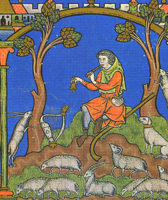en.wikipedia.org
Always private
DuckDuckGo never tracks your searches.
Learn MoreYou can hide this reminder in Search Settings
All regions
Argentina
Australia
Austria
Belgium (fr)
Belgium (nl)
Brazil
Bulgaria
Canada (en)
Canada (fr)
Catalonia
Chile
China
Colombia
Croatia
Czech Republic
Denmark
Estonia
Finland
France
Germany
Greece
Hong Kong
Hungary
Iceland
India (en)
Indonesia (en)
Ireland
Israel (en)
Italy
Japan
Korea
Latvia
Lithuania
Malaysia (en)
Mexico
Netherlands
New Zealand
Norway
Pakistan (en)
Peru
Philippines (en)
Poland
Portugal
Romania
Russia
Saudi Arabia
Singapore
Slovakia
Slovenia
South Africa
Spain (ca)
Spain (es)
Sweden
Switzerland (de)
Switzerland (fr)
Taiwan
Thailand (en)
Turkey
Ukraine
United Kingdom
US (English)
US (Spanish)
Vietnam (en)
Safe search: moderate
Strict
Moderate
Off
Any time
- Was this helpful?
- The medieval English wool trade was one of the most important factors in the medieval English economy. [1] The medievalist John Munro notes that "[n]o form of manufacturing had a greater impact upon the economy and society of medieval Britain than did those industries producing cloths from various kinds of wool."
historic-uk.com
As the wool trade was so successful, he felt he could make some royal revenue to fund his military endeavours by slapping heavy taxes on the export of wool. It was also King Edward I who ordered the total extermination of all wolves in his kingdom and personally employed a Shropshire knight, one Peter Corbet to rid England's western shires ...tetontradecloth.com
Teton Trade Cloth by Lenape
https://www.tetontradecloth.com
At Teton Trade Cloth by Lenape, we are literally searching the world over to bring the finest in materials for the creation of heirloom quality American Indian artwork. We are proud of offer 100% wool trade cloth, trade beads and other rare finds.crazycrow.com
Crazy Crow Trading Post
https://www.crazycrow.com › wool-trade-cloth
Wool Trade Cloth- Sawtooth & Rainbow Selvedge Broadcloth & Stroudcloth From 1700s Stroud Cloth to 21st Century Broadcloth for Gourd Dancers.. Crazy Crow Trading Post manufactures and imports the largest selection of wool trade cloth available for use in Native Amerian Indian outfits and regalia, mountain man / frontier outfits and for a variety ...tudortimes.co.uk
The wool trade expanded in to cloth-making. Instead of most raw wool being exported, it was retained for weaving at home and then exported as the finished product. Villages were full of spinsters, usually women, spinning the raw wool into yarn, and websters, usually men, operating small hand looms in their own cottages.oerproject.com
producers of wool of all, owning 29,000 sheep in 1259. In just one county, Hampshire, as much as 30% of all land belonged to the Bishop of Winchester for the use of his sheep. 03:53 NICK: At first, much of the wool trade was dominated by merchants sent by the manufacturers in Flanders and Italy, but English merchants soon became important.sirgordonbennett.com
But the wool trade really came into the political arena when the Flemish weavers asked Edward III to protect their cloth making towns from their French overlords. Essentially Edward III went to war over wool. To finance the 100 years' war with France, Edward III taxed wool heavily. This though meant that it became expensive for the Flemish to ...histclo.com
The wool trade was especially importnt to the English and developing European economy. The ancient Britons kept sheep and wove wool before the Roman invaded. The establishment of Roman rule (1st century AD) led to important improvements in methods. The Romans built a factory at Winchester. William the Conqueror introduced skilled Flemish weavers (11th century).wooltrade.com
wooltrade.com
https://www.wooltrade.com
all types of wool with offices based in Argentina, The Netherlands and Israel. Micael Berezovsky and Erik de Leeuw, owners and founders of Wooltrade B.V., have gained their experience in the international wool trade for over more than a decade now. Our knowledge of the wool market is based upon many years of trading in South-America, the Far East,husfarm.com
Feb 18, 2024The wool trade has a storied history, deeply entwined with the economic and political landscapes of nations. Historically, wool was one of the first commodities to be traded internationally, playing a pivotal role in the economies of medieval Europe. England, in particular, emerged as a dominant player, with its woolen exports being a ...Can’t find what you’re looking for?
Help us improve DuckDuckGo searches with your feedback
